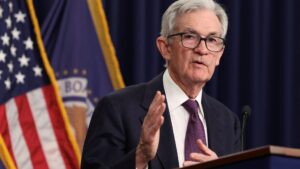Understanding the Federal Reserve’s Latest Decisions: What It Means for Investors
If you’ve been keeping an eye on market trends, you’re likely aware of the recent decision made by the Federal Reserve to hold interest rates steady—a move widely anticipated by investors. However, what has caught the attention of analysts and market participants alike is not just the decision itself, but rather the implications of what was left unsaid in the Fed’s post-meeting statement. Here at Extreme Investor Network, we take pride in digging deeper to provide our readers with a comprehensive understanding of these financial developments.
A Significant Omission in Fed Language
In a pivotal shift, the Fed removed the phrase stating that inflation "has made progress toward" its 2% target, a language that had been included in previous statements. Instead, it chose to affirm that inflation remains "somewhat elevated." This subtle yet critical alteration sent ripples through the markets, which quickly reacted—stocks fell to session lows after the announcement, indicating that investors interpreted this as a sign the Fed plans to keep interest rates on hold until further improvements in inflation are observed.
Ian Lyngen, head of U.S. rates strategy at BMO Capital Markets, noted the gravity of this change. He pointed out that the removal of assertive language around both inflation and employment suggests that the Fed is pressing the pause button, indicating a potential stall in the trajectory towards easing rates.
Market Sentiment and Future Projections
Seema Shah, the chief global strategist at Principal Asset Management, reinforces this sentiment, stating that "the omission of inflation progress from the FOMC statement can be seen as a hawkish signal." She argues that with inflation plateaus observed, a rate cut doesn’t appear to be urgently needed right now, making the Fed’s pause justifiable.
It’s essential for investors to recognize the cautious stance the Fed is taking, particularly in an unpredictable economic climate influenced by changing government policies. As central banks strive to stay ahead of the curve, they must navigate through economic data and policy shifts, making informed decisions without a forecasting edge.
The Role of Economic Data in Fed Decision-Making
During his press conference, Federal Reserve Chair Jerome Powell explained that the shift in language was more about "clarity" than signaling a new direction in policy. Nevertheless, Claudia Sahm, a former Fed economist, urged caution. She emphasized the importance of not overinterpreting these nuances, reminding investors that inflation remains the central issue at hand.
As we look ahead, the recent market reactions underscore the realization that the Fed’s data-driven approach makes the forecasting for monetary policy, especially past 2025, increasingly complex. Should the upcoming economic data show a continued decrease in inflation or a notable softening in job growth, we might anticipate a more dovish tone from the Fed, shifting the landscape for interest rate policy once again.
Conclusion: The Investor’s Takeaway
For investors, these developments serve as a crucial reminder of the inherent volatility in financial markets—especially following announcements from the Federal Reserve. It’s essential to stay informed, remain adaptable, and approach your investment strategy with a clear understanding of broader economic trends and the factors affecting monetary policy.
At Extreme Investor Network, we commit to keeping you well-informed about the latest financial news, helping you make educated decisions in an ever-changing market. Stay tuned for more insights and analysis to help you navigate these uncertain times confidently.

